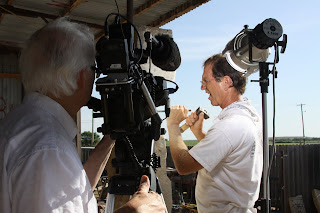After multiple triple-digit days accompanying Wichita's finest reporters and photographers around south-central Kansas, it is time for me to return to school in Lawrence.
From crime to crops, and from the aviation industry to tornado victims, this summer has been quite an adventure. I've gone to all corners of the city on stories, including many of the small suburb towns. But, as far as 'long-distance' travel goes, I went to stories in:
- McPherson
- Hutchinson
- Newton
- Augusta/Towanda
- Wellington
- Sun City
- Lucas
 This summer has been memorable for multiple reasons, but the days I spent at KAKE were always exciting and educational. It will be hard, I think, to leave it and go back to school. But, if I didn't go back, how would I ever use the knowledge I accumulated this summer?
This summer has been memorable for multiple reasons, but the days I spent at KAKE were always exciting and educational. It will be hard, I think, to leave it and go back to school. But, if I didn't go back, how would I ever use the knowledge I accumulated this summer?And today's adventure in storytelling was no different... In fact, it was probably the best day so far.
Today was last day interning at KAKE-TV, and I got another great opportunity to work alongside Larry Hatteberg as he filmed his latest "Hatteberg's People" story.
As we left Wichita this morning, the clouds seemed to follow us all the way up I-135 to Concordia and Cloud County. There was a notable difference in the landscape between the two counties: Sedgwick was brown and dry; Cloud, green and lush. The stalks of corn and milo waved in the gentle wind as we drove by on the blacktop to St. Joseph, Kansas.
This small community of 15 or so residents (not to be confused with St. Joe's Ost in Sedgwick County), resides a few miles outside of Clyde, near Concordia.
Even as we were still a few miles away from the town, we could already see the towering church steeples. As the town was a French community, it appeared that they had modeled their church, St. Joseph Parish, after Notre Dame Cathedral.
And, like many older, farming communities, the town was centered around the church, which was no longer being used by the diocese.
The other main attraction was our story: The St. Joseph Store, owned by the Girard family. Originally built in 1888, the Girard family took over the store a few years ago after it had been closed for nearly 20 years. They opened it up as a part-time restaurant in May, and said they enjoy seeing the community come together at the store -- just like it used to before it closed down.
 The whole time we were working on the story, I couldn't help but think of the fact that it was my last day. But, as I talked to Larry on our way to and from Cloud County, I became more reassured -- about the future and about the past.
The whole time we were working on the story, I couldn't help but think of the fact that it was my last day. But, as I talked to Larry on our way to and from Cloud County, I became more reassured -- about the future and about the past.Of all the things I contemplated about or had the opportunity to do this summer, I am satisfied in my choice to intern at KAKE-TV. As I go back to school, my classmates will tell me about their internship experiences -- some at local TV stations or newspapers; others, at national affiliates like USA Today or ESPN.
But, KAKE will always be my home. I watched it as a child, fascinated with the stories they told, the people they encountered, and the community they effected. I wouldn't have wanted to intern anywhere else this summer.
 It was an amazing experience, but it's time to turn the page in my story. This chapter has already been written.
It was an amazing experience, but it's time to turn the page in my story. This chapter has already been written.Did I learn a lot? Yes, as I hope you readers have witnessed first-hand.
 Did I have fun? Yes, as much as you can have when you cover both inspiring, indifferent, and depressing news stories.
Did I have fun? Yes, as much as you can have when you cover both inspiring, indifferent, and depressing news stories.As I said my goodbyes to the reporters, photographers, producers, anchors, directors, and editors, I felt relief and satisfaction -- relief in knowing that the summer (and the heat) was mostly over; satisfaction in knowing that I had done my best and absorbed all the knowledge that I could.
I also take pride in the fact that I worked with some of the best in the business, and I hope that my own work demonstrates all of the great lessons that they have taught me.
As I go forward in my journalism and story-telling career, all I can do is persevere through all obstacles and always do what I think is right.
At least, that's what my teachers taught me this summer at KAKE-TV.












